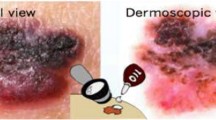Abstract
Early detection of melanoma has critical importance for the success of the treatment. However, a successful early diagnosis is only possible with the existence of discriminative features. In this study, a new descriptor based on the number of colors was developed in order to successfully diagnose lesions of melanoma. The number of colors is the main feature in the identification of melanoma-type skin lesions. The user must select a threshold value when calculating the number of colors of the lesion. The incorrect threshold value selection of non-expert users disrupts the aforementioned feature and also leads to significant diagnostic errors. In this study, it was revealed that color counting threshold values have a significant effect on the distinctiveness of the number of colors. In the three dermoscopic databases, color counting threshold values that provide the maximum distinctiveness on melanoma and benign lesions were determined as 0 and 0.123 respectively. By using these color counting threshold values, the number of colors for each sample in the data sets was calculated separately. Following that, a novel attribute called the number of color difference was defined as a function of color counting threshold values. Experiments using only the proposed new descriptor yielded 52.7% higher f-measure and 84.5% higher true-positive performance than the number of colors used in the literature. The results obtained in this study revealed the importance of accurately determining the number of colors the lesions had and states that the applied color counting threshold significantly influences the classification results. Thereby, a new method is proposed for determining the critical color counting threshold. We claim that the classical ABCD rule should be improved by our new descriptor.

Fig. 1 Selection of threshold has vital effect on skin lesion classification. A new method to select the correct threshold value and a new attribute for correct classification were developed








Similar content being viewed by others
References
Scioll B, Delachartre P, Cowell L et al (2017) Improved boundary segmentation of skin lesions in high-frequency 3D ultrasound. Comput Biol Med 87:302–310. https://doi.org/10.1016/j.compbiomed.2017.06.012
Davidson NE, Armstrong SA, Coussens LM, Cruz-Correa MR, DeBerardinis RJ, Doroshow JH, Foti M, Hwu P, Kensler TW, Morrow M et al (2016) Aacr cancer progress report 2016. Clin Cancer Res 22:S1–S137
Tajeddin NZ, Asl BM (2018) Melanoma recognition in dermoscopy images using lesion’s peripheral region information. Comp Methods Program Biomed 163:143–153
Garnavi R, Aldeen M, Celebi ME et al (2010) Automatic segmentation of dermoscopy images using histogram thresholding on optimal color channels. Int J Med Med Sci 1(2):126–134
Ciecholewski M (2017) Malignant and benign mass segmentation in mammograms using active contour methods. Symmetry 9:277. https://doi.org/10.3390/sym9110277
Abbas Q, Fondón I, Rashid M (2011) Unsupervised skin lesions border detection via two-dimensional image analysis. Comput Methods Prog Biomed 104:1–15
Sirakov NM, Ushkala K (2009) An integral active contour model for convex hull and boundary extraction. In: Bebis G et al (eds) Lecture notes in computer science. ISVC’2009, vol 5876. Springer, Verlag, pp 1031–1040
Sirakov NM (2006) A new active convex hull model for image regions. J Math Imaging Vis 26(3):309–325
Mete M, Sirakov NM (2012) Dermoscopic diagnosis of melanoma in a 4D space constructed by active contour extracted features. Comput Med Imaging Graph 36:572–579
Sirakov NM, Ou YL, Mete M (2015) Skin lesion feature vectors classification in models of a Riemannian manifold. Ann Math Artif Intell 75:217–229. https://doi.org/10.1007/s10472-014-9424-8
Menzies S, Ingvar C et al (1996) Frequency and morphologic characteristics of invasive melanomas lacking specific surface microscopic features. Arch Dermatol 132:1178–1182
Bakheet S, An SVM (2017) Framework for malignant melanoma detection based on optimized HOG features. MDPI Comput 5(4). https://doi.org/10.3390/computation5010004
Alquran H, Qasmieh IA et al (2017) The melanoma skin cancer detection and classification using support vector machine. IEEE AEECT
Nachbar F, Stolz W, Merkle T et al (1994) The ABCD rule of dermatoscopy: high prospective value in the diagnosis of doubtful melanocytic skin lesions. J A Acad Dermatol 30–4:551–559
Dalila F.,Zohra A., Reda K., Hocaine C. (2017) Segmentation and classification of melanoma and benign skin lesions. Optik 140:749–761. 1016/j.ijleo.2017.04.084
Faziloglu Y, Stanley RJ, Moss RH et al (2003) Colour histogram analysis for melanoma discrimination in clinical images. Skin Res Technol:147–155
Marghoob AA, Malvehy J (2012) Atlas of dermoscopy 2edn, Informa Healthcare
Russo T, Piccolo V et al (2016) Review-recent advances in dermoscopy. F1000Research 5(F1000 Faculty Rev.):184. https://doi.org/10.12688/f1000research.7597.1
Abbadi NKE, Faisal Z (2017) Detection and analysis of skin cancer from skin lesions. Int J Appl Eng Res 12(19):9046–9052
Gautam D, Ahmed M, Meena YK, Haq AU (2018) Machine learning–based diagnosis of melanoma using macro images. Int J Numer Method Biomed Eng 34(5):e2953. https://doi.org/10.1002/cnm.2953
R.C.Gonzalez, R.E. Woods (2008) Digital image processing, 3rd edn., Pearson Prentice Hall
Argenziano G, Soyer HP, De Giorgi V et al (2000) Interactive atlas of dermoscopy. Edra Medical Publishing and New Media, Milan
Inza I, Larranaga P, Blanco R (2004) Filter versus wrapper gene selection approaches in DNA microarray domains. Artif Intell Med Cilt-31:91–103
International Skin Imaging Collaboration. Web site. www.isic-archive.com. Accessed 12 March 2019
Mete M, Sirakov NM (2010) Lesion detection in demoscopy images with novel density-based and active contour approaches. BMC Bioinform 11(Suppl6):23. https://doi.org/10.1186/1471-2105-11-S6-S23 [ISSN: 1471–2105, 10.07.2010]
Sirakov NM, Mete M, Chakrader NS (2011) Automatic boundary detection and symmetry calculation in dermoscopy images of skin lesions. In: IEEE ICIP2011, p. 1637–40. [ISBN: 978–1–4577-1302-6, IEEE Xplore]
Author information
Authors and Affiliations
Corresponding author
Additional information
Publisher’s note
Springer Nature remains neutral with regard to jurisdictional claims in published maps and institutional affiliations.
Rights and permissions
About this article
Cite this article
Akan, H., Yıldız, M.Z. Development of new descriptor for melanoma detection on dermoscopic images. Med Biol Eng Comput 58, 2711–2723 (2020). https://doi.org/10.1007/s11517-020-02248-z
Received:
Accepted:
Published:
Issue Date:
DOI: https://doi.org/10.1007/s11517-020-02248-z




